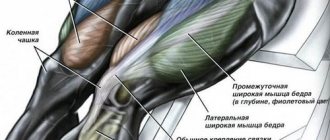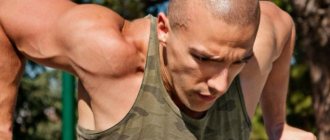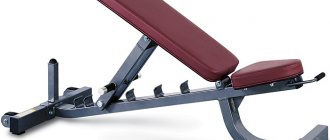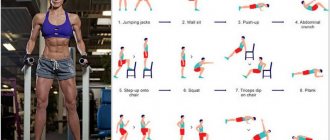Well-developed deltoid muscles are the key to a beautiful physique and broad, pumped-up shoulders, which many dream of getting. But not everyone takes into account three bundles of deltoid muscles at once when training. And this is a huge mistake.
Proper and even muscle building in all three parts of the shoulders gives them a three-dimensional, round and truly voluminous appearance. If you forget about one of them, all your work is in vain.
Don't believe me? Here are a couple of recent snapshots of my personal progress:
As you can see, it is the balanced development of the anterior, lateral and posterior deltoid muscles that gives my shoulder its complete appearance.
Shoulder structure
To better understand all this, let's look at the structure of the shoulders.
Like the triceps, the deltoid muscle is divided into 3 main parts. Anterior, lateral and posterior heads (bundle). They are also commonly referred to as the anterior, middle and posterior deltoids or deltoids.
All 3 bundles will work to one degree or another during the exercises. But each of them swings fully only when performing a certain type of movement.
In this article I will share the top shoulder workout, compiled and optimized based on:
- The most current scientific literature.
- Anatomical structure of the shoulder muscles.
But before we do that, let's talk briefly about the front delts.
Why don't my deltoid muscles grow? (How to fix it?)
Are you often looking for ways to pump up your shoulders, but there are no results yet? I can congratulate you, you have come across the right article and will be able to solve this issue. Here I will clearly demonstrate how to properly pump and quickly build up the deltoid muscles in order to ultimately get bigger and stronger shoulders.
For many, the deltoids are an extremely difficult muscle group to train. It is worth noting that for most athletes it is not difficult to work the front delts, but when it comes to the lateral delts, this is where the difficulties begin. The lateral delts are precisely the muscles that demonstrate our texture and determine the width of the shoulders, which many strive to increase in volume.
But in practice, working out the side delts is not so difficult. Dumbbell lateral raises are generally the most effective way to achieve great results. And in fact, perhaps many of you who are reading this article perform similar exercises in everyday life, often without noticing it.
But then why don’t you see muscle growth in your shoulders? And you constantly wonder: how to pump up deltoids? So, in fact, it all depends on how correctly you perform the exercises, which at first glance are very simple.
Incorrect technique for performing dumbbell flyes
It's actually very rare to see gym goers actually perform this exercise properly. Instead of pumping specifically the lateral delts, they actually and unconsciously train other muscle groups. This occurs because athletes put unnecessary tension into their movements, swaying from side to side, back and forth while performing the required movements.
The upper trapezius muscles take on some of the work and relieve the load on the deltoids
In addition to this, one of the lesser known causes that we are not even aware of is the upper trapezius muscles. There are many reasons why they take most of the load from the deltoid muscles during exercise. Here are the most important reasons:
- Anatomical features of the upper trapezius muscle.
- A hyperactive state of this muscle group, due to a person being in a hunched position for a long time during the day.
For clarity, you can look at the photo below. This shows how the upper trapezius muscles work, and they are the ones that lift the shoulder. At that time, it can be seen that the deltoids are designed to raise the arms to the sides.

So, many of us who will perform raises with dumbbells will also involve our shoulders in the work, so that it is simply easier. This usually happens at the very beginning and at the end of performing a certain number of repetitions of a given exercise.
When you move dumbbells from point A to point B, the side delts lose their engagement at the end of the set. The amplitude is reduced and the movements become incorrect.
How to Minimize Upper Trapezius Muscle Involvement
The problem is also that many people make this mistake on a subconscious level. In practice, it turns out that over time, a familiar mechanism of action is developed and, when we spread our arms to the side, it is the upper trapezius muscles that are activated, not the deltoids.
Of course the trapezius muscles will always be involved to some extent, but they should not be the main ones. And since our main goal is precisely pumping up the deltoid muscles, creating strong and large shoulders, it is necessary to minimize the involvement of the upper trapezius muscles in the training process.
So, how to train correctly.
Shoulder training in the gym for mass
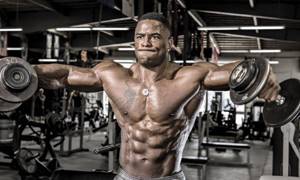
For beginners who have recently come to the gym, it is enough to do a couple of basic exercises. Sometimes even one is enough. Experienced athletes require much greater loads. To pump up each bundle, they must perform 2-4 isolating and 2-3 basic exercises.
The number of approaches, according to the advice of experts, should be 3-4 times, and repetitions in each 8-12. This intensity is suitable for those athletes who train to increase mass. When an athlete is working to improve strength, repetitions in approaches are reduced to a minimum of 4-6 times.
The program includes:
- Military press performed while standing.
- Dumbbell press, which is done in a sitting position.
- Pull the barbell towards the chin, holding the bar with a wide grip.
- Three variations of dumbbell swings, lifting weights while standing, bent over, in front of you.
All exercises are performed 3-4x8-12. This applies to every swing variation.
This training program is not suitable for beginners. It is designed for athletes who have been training for more than one year. Less experienced athletes should remove isolation exercises such as swings.
To prevent muscles from adapting and continuing to progress, experienced athletes periodically make changes to the training process. The greatest effect comes from forced repetitions, drop sets and supersets.
Incredible shoulders, how to pump them up - Stanislav Lindover!
How to start shoulder training the right way
First of all, you need to learn how to perform a basic exercise. This exercise will help you quickly learn how to turn off the trapezius muscles when you do dumbbell raises to the sides.
Some questions will go away after watching the video:
The exercise must be performed in a sitting position. Hold a dumbbell (2kg to start) in one hand, or you can even try doing it without weights at first. Place your other hand on your upper trapezius muscle and begin to slowly lift the dumbbell at about a 45-degree angle in front of you. During the exercise, monitor the condition of the upper trapezius muscle. You need to make sure that she is in a relaxed state and does not tense up.
As soon as they begin to tense up, you need to return to the starting position and repeat it all over again. That's why when you lift a dumbbell, think about the following:
- As you lower your shoulder down, make sure that the upper trapezius muscle does not contract.
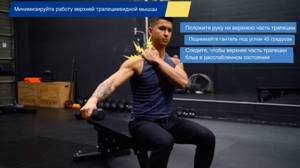
If you are standing, fix the band between your foot and the upper trapezius muscle, as in the photo below, this will help you feel how correctly you are performing the exercise. When you lift the dumbbell, the band will also rise, indicating that the muscle is tense.
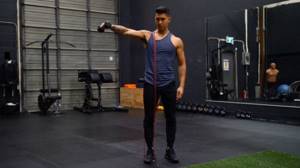
The main goal of this exercise is to lift the dumbbell with full range of motion and keep your arm parallel to the floor without straining the upper trapezius muscle. Many of you, even using light weights, will only be able to do a quarter of the entire range of motion before the trapezius muscle is involved in the work. There's really nothing wrong with this, you just need to keep training. You should focus on performing this exercise correctly and soon everything will work out.
Continue training and gradually increase the working weight. Then you can move on to performing dumbbell raises to the side with both hands at the same time. And don’t forget about the tips described above.
A few additional tips
And while you're practicing, we've got some additional helpful tips and tricks you can experiment with a little:
- Imagine that a horizontal bar is installed at the level of your deltoids, which does not allow you to raise your shoulders above this limit. So, don’t let your shoulders rise above this mark, the so-called invisible barrier.
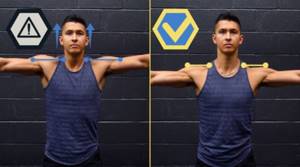
- Don't just think about how to lift the dumbbell. Instead, think about how you can lift the dumbbell further away from your body. This is the type of execution that will be most effective.
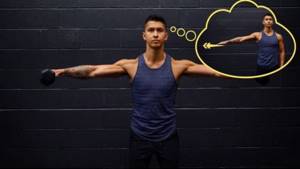
- And some general recommendations. Experiment by taking a dumbbell without using your thumb and lifting it to the level of your shoulder blade. By lifting the dumbbell in this way, you will work the deltoid muscles as much as possible.
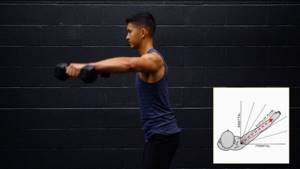
You may notice that the less the upper trapezius muscles are involved in the training process, the more effectively the deltoids work. And as a result, the deltoid muscles will begin to get tired quickly. At the same time, the working weight may decrease, since now we are doing the exercise correctly, and this is much more difficult than it was before. Now the muscles that we wanted to work are tensed, and without the involvement of the upper trapezius muscles, which partially compensated for the load, the exercise becomes very effective. Start with light weights and gradually increase the load. Try to do the exercise correctly.
Options for lifting dumbbells to pump up your shoulders
Alternatively, you can try another version of the exercise. You can control the position of the body, the main thing is to minimize the participation of the upper trapezius muscle during training.
#1 – Using an Incline Bench
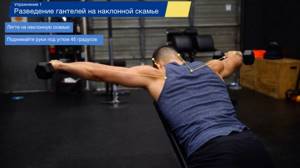
You can use an incline bench. To do this, you need to take the starting position, as seen in the photo, and begin to lift the dumbbells up at an angle of 45 degrees. An incline bench helps ensure proper and stable work of the deltoid muscles. In this way, the participation of the upper trapezius muscles is minimized and only the delta is worked. But don't think that everything is so simple and easy. Even a weight of 2-5 kg can seem quite serious if the exercise is performed correctly.
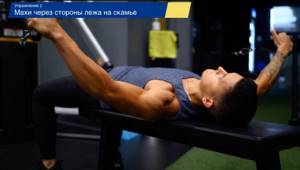
Lateral swings with a cable in a prone position
You can also try a side swing using a cable while lying down. As studies have shown, it is in this position that the load on the upper trapezius muscle is reduced and the deltoids are thus perfectly pumped. Here you do not overcome gravity, but concentrate specifically on the deltoid muscles. It is these conditions that are the best and most effective, since constant resistance from the tensioned cable is ensured throughout the entire amplitude of movement. But you should also not forget to concentrate your thoughts on exactly those muscles that you are working.
Do I need to isolate the front delts?
As I mentioned earlier, it is important to pump and engage all three parts of the shoulder. But keep in mind that the front deltoid is already quite active and receives a lot of load during various exercises, such as push-ups.
The anterior deltoid muscle is very active in exercises such as the bench press.
Moreover, the greater the level of inclination, the more load falls on the front bundle during the pressing movement. I'm sure most of the exercises in your plan target this muscle to some degree. Therefore, in this article, exercises have been selected that load the lateral and posterior head of the deltas to a greater extent. After all, it is these two components of the shoulder muscles that are most often neglected.
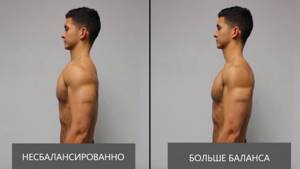
A comprehensive approach to shoulder training not only makes your shoulders look aesthetically pleasing, but also, as one study states, “strengthening the posterior head of the deltoid muscle is essential for maintaining shoulder joint integrity and reducing the likelihood of injury.”
That is why in this article we will pay enough attention to the lateral and posterior heads of the humerus.
Also keep in mind that the four muscles of the pleural girdle are quite important muscles that should not be neglected. Why? Because they help stabilize the shoulder. But more on that in another article.
Pumping up the delts with seated dumbbell presses
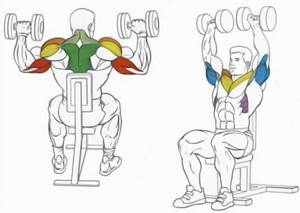
Proper pumping of the delta through the seated press
This technique of working with the delta ensures intensive growth of the anterior bundles. In addition, the upper chest and middle bundles are also additionally loaded.
The exercise is performed as follows:
- We take dumbbells and sit down straight on a horizontal surface (for example, a bench).
- You need to hold dumbbells with a straight grip in bent arms so that they are located near your ears.
- Now we lift the dumbbells up, straightening the elbow joints. We do this slowly, which will increase the effectiveness of the training.
- We linger for a second at the very top.
- You should also stay in the bottom position for a second.
We also recommend studying this topic:
Arm training for girls in the gym
10709 0 0
Advice! In the lower position, you can touch your shoulders with your hands - this is a completely normal position.
An overhand grip will allow you to engage the lateral and front heads of the deltoid muscles. It is possible to load the front bundles perfectly with neutral and reverse grips.
For variety, you can combine your grip. So, let's start lifting with a regular grip. Having reached the middle of the lift, you need to begin to turn your hands, which will allow you to get a direct grip at the top point. It would also be a good idea to combine simultaneous lifting of dumbbells with alternate lifting.
We also recommend that you pay attention to the article: “Exercises with dumbbells at home”
This material will be perfectly complemented by the following publications:
The best exercises for properly training the deltoid muscles
So, to achieve excellent results, I have prepared an action plan. First of all, you must consciously approach your training. Start with light weights and gradually increase the pace. Pay attention to the exercise options described above. When you understand that it is the deltoid muscles that are working, you can begin to perform the exercise in a standing position without additional equipment and without prompts. The main thing is that the upper trapezius muscles do not work in conjunction with the deltoids.
You can also experiment with the exercises mentioned above. The most important thing we want to avoid is performing exercises incorrectly when the upper trapezius muscles are involved. Start with light weight and gradually with experience everything will come.
Exercise 1: Overhead press (focus on front and side delts)
The overhead press is an important compound exercise when it comes to training your shoulders. This is due to the fact that with the help of this movement it is easy to influence the muscles with weight and use all the bundles of the deltoid muscle. I'll talk about several variations of this exercise. But note that they all primarily target the anterior deltoid with some involvement of the lateral and posterior head.
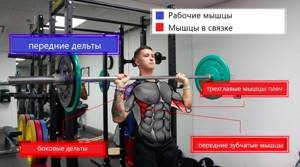
The standing press also targets the core and serratus anterior muscles.
Benefits of the Overhead Press
This exercise is considered the best for developing and loading the anterior deltoid muscle.

In fact, the barbell overhead press outperformed dumbbell curls by 41%. This will be the only exercise you need to include in your front delt training program.
As for which option is most effective, it’s up to you:
- Standing overhead press;
- Standing overhead dumbbell press;
- Seated barbell press;
- Seated dumbbell press.
Variations of Overhead Presses
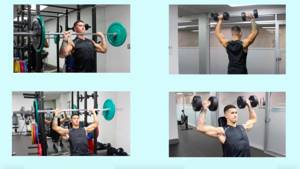
It has been proven that, compared to any other exercise, the standing dumbbell press puts more stress on:
- front,
- Lateral,
- And the posterior deltoids.
Choosing the Overhead Press
Plenty of research shows that the dumbbell overhead press is the best option. But I think it’s better to give preference to barbell presses, especially if you need a lot of weight.
They are not far behind the standing dumbbell press in terms of overall shoulder activation. And they are superior to seated options, too.
This does not make other options any less effective. Moreover, it is worth periodically alternating the different types of presses described above.
For example, if standing presses no longer produce the desired results, feel free to move on to seated dumbbell presses. If you are tired of doing the same exercise for several months, it is also worth changing the variation. However, I would advise sticking with one variation for a long period of time before considering changing variations.
Exercise 2: Lateral Raises (focusing on the lateral deltoid)
This exercise is usually performed in the gym. I highly recommend it for developing side buns. It targets primarily the lateral deltoid muscle with moderate involvement of the other two heads and the upper trapezius muscles.
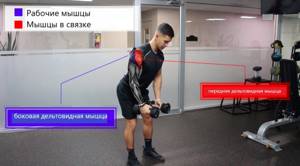
This exercise is the most effective for pumping up the middle deltoid compared to other common shoulder exercises.
It is very popular, and there are many variations of this exercise for men. Let's look at the form of the movement and how to maximize shoulder activation while minimizing stress on the shoulder joint.
How to do lateral raises correctly
The technique is simple, but there are pitfalls. When you lift weights from the sides of your body, the activation of each part of the deltoid depends on how much it is in a straight line of force opposite to gravity.
Without rotating the shoulder, you can see that the lateral deltoid as well as the anterior deltoid are in a straight line of force opposite to gravity. This means that they will be used to the maximum during lifting.
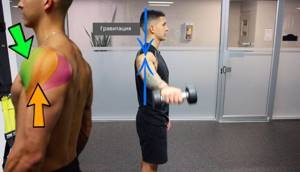
To rotate your shoulder inward, imagine that you are pouring water from a jug. This will remove the front bundle of the deltoid muscle from work and force the lateral deltoid to move in a straight line of force, receiving maximum load.
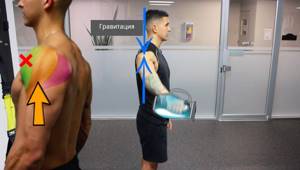
It is worth noting that this is a fairly dangerous position for the shoulder joint and can lead to wear and tear and damage to the shoulder in the long run.
To correct this, you need to straighten your shoulders and move them out to the sides.
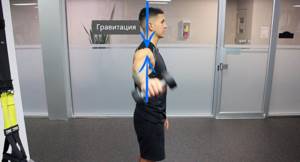
But you may notice that the muscle on the direct line of force is the anterior deltoid. To solve this problem and place more emphasis on your middelt, you can use one of two options.
Side lift options
Option 1: Lean forward slightly so that your lateral deltoid is more on the line of force.

Option 2: Do the exercise on an incline bench, it's the same idea.
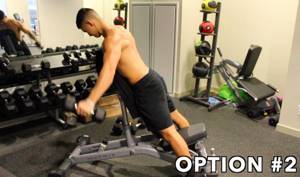
But in both cases, you need to make sure that you rotate your shoulder outward slightly.
Exercise 3: Reverse flyes on the machine (for the rear deltoid)
Now we're going to put more emphasis on the rear delts. As I mentioned earlier, pumping them is necessary for the symmetrical fullness and relief of the shoulder muscles and the proper functioning of all the muscles of the shoulder girdle. This exercise focuses on the posterior deltoid, but also works other secondary muscles.
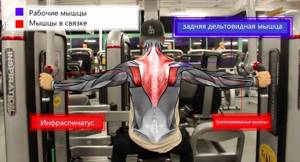
Research has shown that reverse flyes engage the rear delts more than seated rows and high pulldowns. This means that incorporating them into your training regimen is essential for optimal rear delt development.
Which grip is most effective? A neutral grip, with the palms facing each other, produces higher activation of the posterior deltoid and infraspinatus than a pronated palm grip, with the shoulders turned inward and the palms facing down.
Why is that? Well, in addition to horizontal abduction, the posterior deltoid also functions to externally rotate the shoulder. Because a neutral grip involves more external rotation than a pronated palm grip, it causes greater activation of the rear deltoid muscles.
A pronated palm grip can overstretch the posterior deltoid and prevent it from developing adequate strength due to its length-tension relationship.
Grip Variations

Any of the variations have a chance of life, because it may turn out that one of these grips will be the most effective for you.
Exercise 4: Weight rows to the face from a prone position
This exercise is my favorite when it comes to completely isolating the rear delts. And I highly recommend you try it. Although this variation will target the same muscles as a traditional standing row, it will reduce the work of the upper trapezius muscles.

The upper trapezius muscles are most active during standing exercises as they work to maintain a certain position in space of all or part of the body.
Thus, performing the exercise while lying on the ground:
- Eliminates the effects of gravity and
- May reduce excessive activation of the upper trapezius muscles.
This is exactly what we need, because often we don’t even notice how we overload the unnecessary muscles. Let's say that overactive trapezius muscles tend to outperform the rear deltoids in many movements. Lying down will correct this.
The most effective exercises for the rear delts
Types of muscle fibers in the shoulders
In terms of fiber type, numerous studies have shown that the shoulders have approximately an equal 50/50 ratio between Type I and Type II muscle fibers.
It is widely believed that:
- Type I fiber growth is best stimulated by high repetitions with light weights.
- Type II fiber growth is best stimulated by low repetitions with heavy weights.
Some studies agree with this. However, others show that both types of fibers will grow regardless of the rep range used.
But I think the research is still leaning toward including a varied range of repetitions while taking into account the distribution of fiber types. Thus, I think that both high and low reps in your training will be the best option from a hypertrophy standpoint.
Research results
After finishing the training part of the experiment, specialists analyzed the statistical data and presented them in three tables - for each bundle of deltoid muscles.
1. The most effective exercises for activating the anterior deltoid muscles:
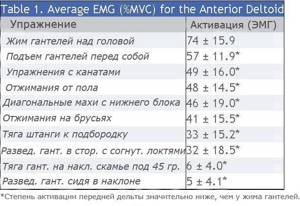
2. The most effective exercises for activating the middle deltoid muscle:

3. The most effective exercises for activating the posterior deltoid muscles:

Maximum activation of the anterior deltoids was observed during the overhead dumbbell press.

The overhead press is the most effective exercise for the anterior deltoids.
The middle deltoid was activated to its maximum values when performing two exercises: dumbbell rows on an incline bench at an angle of 45⁰ and dumbbell lateral raises with bent elbows.
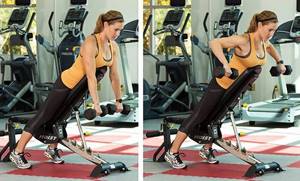
Incline dumbbell rows are one of the most effective exercises. The best for activating the muscles of the middle bundle and in second place is for activating the muscles of the posterior deltoid bundle.
Maximum activation of the posterior deltoid was observed when performing seated dumbbell flyes and dumbbell rows on an incline bench at an angle of 45⁰.

The best exercise for the back of the deltas: raising your arms to the sides while sitting in an inclined position.
Sample training program
Here's an example of a workout you can do using the basic exercises previously described. They can be swapped, new ones added, or divided into two if you train shoulder width more than once a week.
- Overhead press: 3-4 sets of 6-10 reps.
- Lateral raises: 4 sets total (2 sets of 6-10 reps, 2 sets of 12-15 reps).
- Reverse flyes : 4 sets total (2 sets of 6-10 reps, 2 sets of 12-15 reps).
- Weight rows to the face from a lying position: 2 sets of 8-12 reps.
- Weight rows to the face from a standing or kneeling position: 2 sets of 8-12 reps.
And finally
In general, you should understand that if you are struggling to build certain muscle groups, then most likely this is the result of a conscious and careful approach to the goal. There must be a step-by-step program that should lead to the desired result. Don’t forget about science, it is she who gives the right advice that you should listen to. You need to train not only all day long, but also do it correctly, accurately and with maximum efficiency, combining this with a correct and balanced diet, and also do not forget about the mandatory recovery after training.
Sources:
- builtwithscience.com/shoulder-workout-science/
- builtwithscience.com/how-to-build-shoulders/
Shoulder Exercises, Sets and Reps
Rear delts
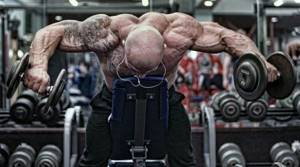
To pump up the posterior deltoid muscle, 3-4 working approaches (excluding warm-up) in an isolation exercise should be enough.
It may seem like one exercise isn't enough, but remember that one of the functions of the rear deltoids is to externally rotate the humerus. So if you're doing a few shoulder external rotation exercises each week (as you should be) during your back workouts, then a few sets of one exercise will likely be sufficient.
However, if your rear delts are seriously underdeveloped, then perform two exercises that isolate the rear delts. Perform three sets of each exercise. Here are three effective exercises to choose from:
- Rear deltoids in a standing block
- Bent-over dumbbell swings or rows on the rear delts with your head resting on an incline bench
- Bent-over dumbbell row with rotation Video with exercise technique
Please note that this is not a triceps exercise. This is a movement where you keep your elbows straight and pull your arms back using only your rear delts.
Beware of lifting the scapula to isolate the rear deltoid, keeping the shoulders down at all times. Keep in mind that the function of the posterior deltoid is simply to move the humerus backward without squeezing the shoulder blades together.
No matter what type of rear delt exercise you perform, there are several biomechanical principles to consider. For beginners, to optimize the work of the rear delts, train them at the optimal line of pull, which is formed when the shoulders are abducted (to the sides) by 35-40˚.
It is also necessary to raise your arms with dumbbells in line with your shoulders, pointing your little fingers up. This will align the rear deltoid so that it does the maximum work possible.
When isolating the rear deltoid, the challenge for most people is actually isolating the deltoid to effectively contract the muscle. For this reason, exercises are often performed with light weights with repetitions of 10-15. Performing the exercise with heavy weights for low repetitions is more effective, but wait until the neuromuscular connection of the rear deltoids improves before moving on to heavier weights.
Front delts

To train the anterior deltoid muscle, a barbell chest press is usually used. This is a good exercise to train your shoulders. This is a basic shoulder exercise.
The front delt press can be done with a barbell or dumbbells. It is imperative to change exercises to include shoulder muscle stabilizers to keep your shoulders healthy
Also, bench presses are for the front delts as squats are for the quads. On the other hand, forward raises isolate the front delts in the same way that leg extensions isolate the quadriceps.
If the front delts are your strong point, then focus on the overhead press, with occasional front raises to complement it. This combined with the bench press is all you need to train your delts.
On the other hand, if you need to increase your front delts, then it is better to perform one dumbbell or barbell front raise in addition to the overhead press.
The two best exercises for pressing are the basic barbell overhead press (seated or standing) and the basic dumbbell press, performed seated or standing. Although many set/rep schemes for the overhead press work, it is better to stick with 4*6-10, although 5*5 and 3*8-12 are also good options that should be done correctly.
When it comes to isolating the front delts from the rear, dumbbell front raises are great, but barbell front raises are more effective.
No matter which front raise you choose, make sure the bar is at a 110˚ angle, approximately level with the top of your forehead. This is the peak at which the front delts contract, rather than at 90˚ where most people stop.
When performing variations of front raises, it is preferable to choose a rep range of 3*10-12, sometimes take more weight and do 6-8 reps, sometimes less and do 12-15,
Middle deltas
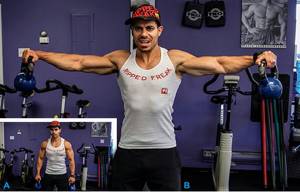
If you want to have shoulders like bodybuilders, you should always include variations of lateral raises to accentuate the middle delts, the most fundamental of which is dumbbell lateral swings.
Even though most people perform lateral dumbbell swings, many do it incorrectly.
For optimal tension of the middle deltoid muscles, the palms should be facing down at the top point. Or, if you really want to hit them hard, tilt the end of the dumbbells down a few degrees so that the inside of your arm rotates slightly upward.
Also, the wrists, elbows and shoulders should be at the same level at the top. Also, the point of your elbow should be pointing straight back, not toward the floor.
At the top of the movement, most people tend to angle the side of the dumbbells too high, causing their wrists to be higher than their elbows. This is because the pattern of this movement allows the front delt to become more dominant to help you out more than you want.
People with very strong upper trapezius muscles also tend to press the dumbbells at a finish position angle close to 90˚. To avoid this, think about pushing the dumbbells out to the sides.
For variety, you can change the point of maximum tension of the middle deltoid muscle by performing one of the following exercise options:
- Lie on your side on an incline bench. Perform dumbbell swings, raising your arm to a 90˚ angle, where the peak contraction of the middle deltoids occurs.
- Bend your torso to the side with the weight as in the video:
If you need to increase your middle delts, it's common to perform three sets of two different shoulder abduction exercises (lateral raises). Perform one exercise in three sets of 8-12 repetitions, and the other in three sets of 12-15. And as usual, sometimes do more difficult or easier ones.
